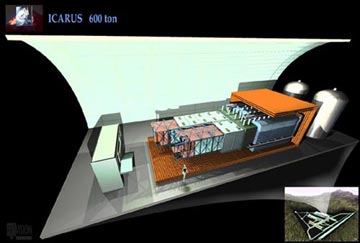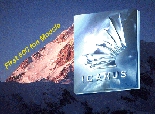Traditional bubble chambers have played a fundamental role in Particle Physics because they provide non-biased images, in three dimensions and with high resolution. The ICARUS experiment represents a new generation of bubble chambers, with the advantage of being operated over a very large sensitive volume (several thousand tons), continuously sensitive, self-triggering, able to provide three-dimensional views of ionizing events with particle identification from dE/dx and range measurements. At the same time, the detector acts also as a good homogeneous calorimeter of very fine granularity and extremely high accuracy
Click here for the official web page
The ICARUS program concerns the usage of Liquid Argon Time Projections Chamber (LAr-TPC) detectors for studies of neutrinos from different sources as well as for searches for proton decay. The LAr-TPC technology was proposed by C. Rubbia in 1977. The feasibility of the technology has been largely demonstrated in the last decades through the operation of several ICARUS prototypes/detectors of small scale (50 liters, 3 tons, 14 tons, ..) and finally with the T600 module. The "bubble chamber" quality of ICARUS images can be easily demonstrated by a typical cosmic ray shower observed in the 3-ton prototype at CERN (fig. 1).

Figure 1: Cosmic ray shower observed in the ICARUS 3-ton prototype at CERN. Photon conversion into pairs as well as pion and muon decays are clearly visible in the electromagnetic showers.
The first large scale detector, exploiting this detection technique, is the ICARUS T600 detector which has been put in operation in May 2010 at the INFN Gran Sasso National Laboratory (LNGS). The data acquisition will continue presumably up to the end of CNGS (Cern Neutrinos to Gran Sasso) beam.
Originally, it was planned to perform the detector upgrade up to 2-3 ktons, by adding modules similar to the existing ones. In 2005 the decision was taken to change the concept in favor of a monolithic detector of this scale. This concept and the possible further developments towards a detector with a total mass of 50-100 ktons of LAr are under discussion.
The ICARUS physics program can provide a background-free detection of neutrino events and proton decays. Atmospheric and solar neutrinos are areas that could be deeply investigated. While a sensitive mass of a few thousand tons of liquid argon is the only way to achieve, in a number of "standard" proton decay channels, the 1034 years range in proton decay lifetime, many other "exotic" channels have only been poorly investigated so far or not at all, and could be easily covered in this first phase with the T600 detector. The same consideration holds for the study of neutrino oscillations with the long baseline neutrino beam from CERN.
The proposal for the first T600 module has been submitted for funding to INFN in 1995 and fully approved in 1996. The final project and designing of all the detector components, including cryogenics, read-out chambers and electronics, have been completed by mid 1998. The construction and test of the detector has been completed in 2001 in Pavia (INFN site). The major industrial counterparts collaborating to the realization of the ICARUS T600 detector were AIR LIQUIDE and STIRLING for the cryogenic system, CINEL for internal detector mechanics and CAEN for the electronics. The T600 detector has been transported at the Gran Sasso underground laboratory in 2004 and the overall plant assembly started as a consequence. The final commissioning and data acquisition start-up occurred in May 2010. A brief description of the detector and the physics program which can be achieved with the ICARUS T600 module at Gran Sasso is given below.
The ICARUS T600 module
The operating principle of the ICARUS liquid argon TPC is rather simple: any ionizing event (from particle interaction or decay) taking place in a volume of liquid argon, where a uniform electric field is applied, produces ion-electron pairs. A fraction of them, depending on the field intensity and on the density of ion pairs, will not recombine and will immediately start to drift parallel to the field in opposite directions. Only the motion of the much faster electrons induces a current on a number of parallel wire planes (the read-out chambers) located at the end of the sensitive volume.
The choice of the liquid Argon as active medium was driven by the following considerations:
- it is an excellent insulator and available at an extremely high purity level, so that free electrons produced by ionization can drift in the liquid over long distances;
- it has a high electron-ion pair yield with respect to the energy deposited in the liquid;
- it is easily available in large quantities (1% of the Earth’s atmosphere).
The main cryogenic container for ICARUS T600 consists of two semi-independent and symmetric parallelepipeds of approximately 3.6 x 3.9 x 19.9 m3. Its walls are made of aluminum honeycomb panels.The thermal insulation uses an innovative method based on vacuum pumped honeycomb insulating material panels.
The read-out chambers (two TPC for each half-vessel) are mounted on the internal walls with the cathode at the centre, to maximize the LAr sensitive volume (corresponding to about 480 ton in mass). A general layout of the T600 detector is shown in Fig.2. The read-out chamber scheme consists of three parallel planes of wires. The wires are oriented at different angles according to the plane (horizontal, +60 and -60 degrees). Information is read both by electric charge induction on the first two readout planes encountered by drifting electrons and by electric charge collection on the last readout plane. The signals from the three wire planes, together with measurement of the drift time, provide a (redundant) full 3-D image reconstruction of the event. The main features of this type of detector is that there is no charge amplification in the chamber, to allow the drifting electrons to induce signals on different wire planes. This requires a high quality electronics to maintain a good signal over noise ratio. In order to allow for higher precision measurements the wire pitch in the read-out chamber planes is 3 mm. The total number of electronic read-out channels is about 54000.

Figure 2: The ICARUS 600-ton detector.
Physics issues
Main physics issues of the ICARUS T600 experiment are the search of neutrino oscillation and the search of nucleon decay events. The neutrino oscillation study can be performed with atmospheric neutrinos, solar neutrinos and long baseline beam neutrinos produced at CERN
Atmospheric neutrinos:
The atmospheric neutrino charged current event rate, expected without oscillations, in one year, for a sensitive mass of about 500 t, is of about 140 events, 80 from νμ; and 60 from νe interactions. These rates correspond to the number of events with a vertex within this sensitive mass. Atmospheric neutrino interactions, with a mean neutrino energy of the order of few hundreds MeV, produce low multiplicity events with a lepton (μ or e) accompanied by a nucleon (p or n) and eventually by one (or two) pion(s). This kind of topologies can be perfectly reconstructed with the ICARUS detector, providing complete information on the incoming neutrino kinematics.
Therefore the ICARUS experiment is well suited to perform, in a few years of exposure, the atmospheric neutrino study with sufficient sensitivity to cover the Super-Kamiokande allowed regions in the neutrino oscillation parameter space.
Solar neutrinos:
The ICARUS device is sensitive to the 8B part of the solar spectrum. If the proposed MSW solution is relevant to explain the solar neutrino deficit, then not only the rate of 8B neutrinos is affected but the shape of the neutrino spectrum should be significantly distorted. Therefore, the ICARUS goal in the solar neutrino area is not only to confront the Standard Solar Model (absolute event rate), but also to provide a Solar Model independent measurement, by observing various independent processes differently affected by possible oscillation. ICARUS can detect solar neutrinos by observing the electron produced in the following two reactions:
- νx + e ---> νx + e, which occurs with all types of neutrino flavors and for both charged and neutral current exchange (about 1 event/ton/yr);
- νe + Ar ---> K* + e, which only occurs with the electron neutrino (about 4 event/ton/yr, including Fermi and Gamow-Teller reactions).
The measurement of the ratio of rates for these two processes provides directly a measurement of the νe oscillation probability.
Long baseline neutrinos:
A detailed feasibility study has shown that it is technically possible to derive a νμ beam pointing to Gran Sasso, 732 km far away in Italy, from a fast extracted proton beam accelerated by the CERN SPS ring. Proton accelerators provide essentially νμ beams from the decay of Π's and K's, produced when the extracted proton beam hits a target. These "parent" particles are focused towards the detector and left to decay in a tunnel to produce muons and νμ . The muons and all remaining hadrons are dumped at the end of the decay tunnel leaving only the neutrinos travelling towards the detector target. The ICARUS T600 sensitivity to long baseline neutrino oscillation is limited by statistics, in case the Super-Kamiokande parameters are confirmed. Therefore a complete study of the long baseline neutrino sector will be accomplished only with a larger detector mass of the order of several kilotons. Nevertheless the use of the ICARUS 600-ton detector will be able to provide preliminary fundamental results during the beam operation start-up.
Proton Decay:
Even with a relatively low mass, the ICARUS T600 experiment can provide important contributions to the proton decay search, in particular for those decay modes (referred as exotic decay modes) with high multiplicities (3 or 4 particles in the final state) or, more generally, with signatures particularly difficult to identify with previously used detector techniques. The ICARUS technique is particularly well suited to identify these decay modes. The detector techniques used so far, especially water Cherenkov detectors, do not allow to study these decay modes in an exclusive mode, as can be argued from the relatively modest present limits. For most of these decays the background in ICARUS is expected to be negligible, hence one single event could be sufficient for discovery. With the T600 module, in a few years, it will be possible to explore a lifetime region exceeding 1032 years for most of these "exotic" channels, with a considerable improvement (a factor 5 to 100) of the present limits. It is evident that with one single module we cannot reach the lifetime limit of 1034 years, needed to fully test the minimal SUSY Gran Unification Theory. This is the final goal for the multi-kiloton detector. Nevertheless, we will satisfy completely the requirement for the first phase of our program , namely to extend the present knowledge of the nucleon stability over the widest possible range of decay modes at the same level of the presently best studied channels.
